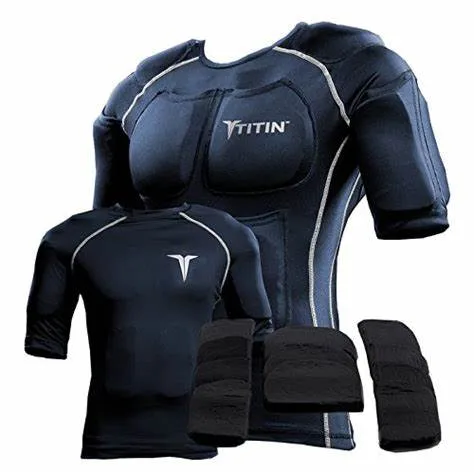Definition
Weighted clothing refers to workout gear such as vests, belts, shorts, and ankle cuffs that have small weighted inserts added to provide additional resistance during exercise.
Explanation
- Wearing weighted clothing during bodyweight exercises like squats, lunges, and push-ups makes the movements more challenging by increasing resistance.
- Weighted clothing follows the principles of progressive overload and muscle building — using added resistance to gradually increase strength, muscle size, and endurance over time.
- Adjustable weighted vests are commonly used so the weight can be increased as the body adapts. Weights of 10-40 lbs are typical.
Examples
- Weighted vest during bodyweight squats
- Wrist weights during bicep curls
- Weighted shorts for walking or running
Related Terms
- Resistance training – Any exercise that causes the muscles to contract against external resistance. Resistance can come from bodyweight, gravity, bands, weights, or other objects that create tension.
- Progressive overload – Gradually increasing the challenge to your muscles over time by adding more sets, reps, weight, or exercise difficulty. Overload promotes continual gains in strength and muscle.
- Weight lifting – A form of resistance training that uses free weights like barbells and dumbbells, or weight machines to build muscle and strength. Lifting heavier weights with lower reps builds maximal strength.
- Strength training – A broad term for any resistance training focused on improving muscle strength, power production, and endurance. Bodyweight exercises, weight lifting, StrongLifts 5×5 and CrossFit incorporate strength training. Building strength improves performance in sports and daily activities.
Common Questions
- How much weight should I start with in weighted clothing? Start with 1-5% of your body weight. For a 150 lb person, that’s 1.5-7.5 lbs. Add weight slowly over weeks as you adapt.
- What exercises can I do with weighted clothing? Walking, running, lunges, squats, push-ups, planks, and most full body exercises. Focus on major muscle groups.
- Are there risks doing weighted exercise? Yes, mainly injury from overloading joints, tendons, and muscles too quickly. Increase weight slowly and ensure proper form. Consult a trainer if unsure.
The key is to start with light weights, perfect your form, and progressively increase the weight over time to continually challenge your muscles without overdoing it. Weighted clothing allows a convenient way to add resistance.
Do Not Confuse With
- Ankle/Wrist weights – Ankle and wrist weights are light weights (1-3 lbs typically) that can be worn to add resistance to exercises. However, they are better used for flexibility training rather than building strength. Heavy ankle/wrist weights can overstress joints. Save heavy weights for supervised resistance training instead.
- Weighted blankets – Weighted blankets are blankets with small beads sewn into them to add weight, usually 5-30 pounds. Weighted blankets provide gentle pressure that can help improve sleep and reduce anxiety for some people. However, they are not intended for exercise – moving vigorously under a weighted blanket can cause injury. Weighted blankets are for relaxation only.
So in summary, ankle/wrist weights and weighted blankets should not be used for exercise or resistance training. They are designed for flexibility and sleep purposes only to avoid injury.
69
/ 100
SEO Score
Thank you for reading this post, don't forget to subscribe to our free newsletter
!
